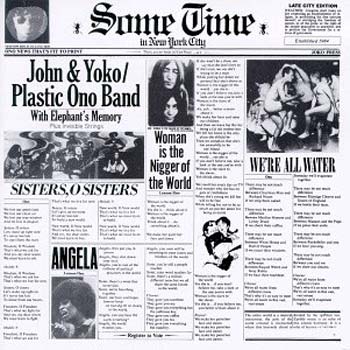
Some Time in New York City (1972)

Disc One
1. Woman is the Ni**er of the World
2. Sisters, O Sisters
3. Attica State
4. Born in a Prison
5. New York City
6. Sunday Bloody Sunday
7. The Luck of the Irish
8. John Sinclair
9. Angela
10.We're All Water
Disc Two
1. Cold Turkey
2. Don't Worry Kyoko
3. Well (Baby Please Don't Go)
4. Jamrag
5. Scumbag
6. Au
Of all the solo Beatles releases, Some Time in New York City remains perhaps the most divisive—and, arguably, the most disappointing. Released in 1972 and presented as a double album of agitprop studio recordings and live performances, it is a document of John Lennon at his most strident, most polemical, and—unfortunately—least musical. What might have been a brave statement of conscience is instead a cautionary tale in how not to fuse art with activism.
The intentions are not in question. Lennon had, by this point, fully embraced his role as political provocateur. Living in New York, surrounded by the countercultural left and emboldened by his relationship with Yoko Ono, he sought to align his songwriting with the causes of the moment—feminism, racial injustice, prison reform, state violence. These were, and remain, valid subjects for artistic expression. The issue lies entirely in the execution.
The album opens with Woman Is the N***** of the World, a track whose title alone guaranteed controversy. Its sentiment is sincere, even defensible within the context of 1970s feminist rhetoric, but its phrasing—however well-intentioned—undermines its purpose. That it remains one of the most musically competent song on the album is a grim omen of what follows. Lennon’s delivery throughout the record is blunt and unfiltered, eschewing metaphor for sloganeering and subtlety for soapboxing. Songs like Attica State, Sunday Bloody Sunday, and Luck of the Irish offer more in the way of protest than poetry. The melodies are forgettable, the arrangements flat, and the lyrical content so didactic it borders on parody. Lennon, once a master of turning personal rage into universal resonance, here sounds more like a street-corner pamphleteer than a songwriter.
Yoko Ono, credited equally, contributes several tracks that only exacerbate the album’s chaos. Her vocal style—deliberately avant-garde—remains as polarizing as ever, and while her political convictions are genuine, her presence on this record is more disruptive than complementary. Even on Lennon’s own tracks, her background vocals often feel intrusive, muddying already overburdened arrangements.
Had the songwriting been stronger, or the production more considered, Some Time in New York City might have weathered its confrontational stance. But too often, the music feels like an afterthought—functional at best, abrasive at worst. There is one moment of clarity in Angela, a relatively subdued and musically competent tribute to Angela Davis, but it arrives far too late to salvage the record’s trajectory.
The second disc, a collection of live recordings featuring the Plastic Ono Band (with members of Elephant’s Memory and Frank Zappa’s Mothers of Invention), offers little relief. The performances are raw to the point of amateurish, and the improvisational chaos of the Fillmore East jam sessions only magnifies the album’s lack of focus. Whatever historical curiosity this material might possess is overshadowed by the grating delivery and lack of coherence.
Lennon had shown before that he could channel his anger into something profound. Plastic Ono Band was deeply personal; Imagine was broadly reflective. Some Time in New York City is simply reactionary—an album more concerned with preaching than connecting. It alienated critics, confused fans, and stands today as a misfire not of belief, but of balance.
There is passion here, but little grace. And for an artist of Lennon’s stature, that is not enough.
Go back to the main page
Go To Next Review